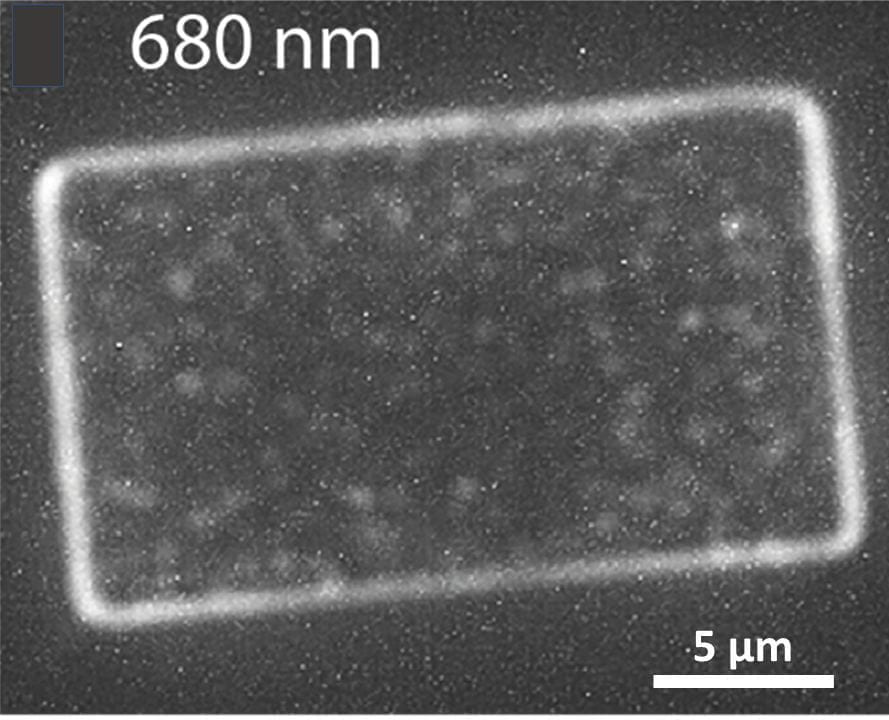Perovskites
Perovskites encompass a diverse range of crystalline materials with the chemical structure A2+B4+X2-3. Some of these are semiconductors with strong light absorption in the visible spectrum, making the material highly attractive for applications in solar energy harvesting applications. Compared with Silicon solar cells, the perovskite active layer in solar cell devices can be processed with solution-phase chemical methods, greatly reducing the energy consumption and cost of device fabrication. Device efficiencies have progressed rapidly over the last decade, reaching 25.2% in single junction solar cells and 29.1% in perovskite-silicon tandem cells.
We are interested in better understanding the excited-state photochemistry in a broad range of perovskite materials and nano-structures.
Perovskite Microplatelets (Chris Hall, Trevor Smith)
Single-crystal perovskite microplatelets are an excellent model system for studying fundamental perovskite photochemistry, owing to their large grain size and low defect density. Using the UML microspectroscopy facility, we can perform high spatial-resolution measurements in a number of fluorescence detection modes : bandpass fluorescence imaging, time-resolved fluorescence imaging, and point-by-point fluorescence spectrum measurements.
One major unsolved problem in mixed organolead halide perovskites, CH3NH3Pb(BrxI1-x)3, is that they undergo phase segregation into iodide-rich domains under illumination, which presents a major challenge to their development for photovoltaic and light-emitting devices. With microspectroscopy and perovskite microplatelets we direct visualize the growth of nanocluster-like I-rich domains throughout the entire. Narrowband fluorescence imaging and time-resolved spectroscopy provided new insight into the nature of the phase-segregated domains and the impact on the optoelectronic properties.
Figure 1. Widefield fluorescence image of phase segregated mixed-halide perovskite.
Low-Dimensional Perovskites (Fei Zheng, Trevor Smith, Ken Ghiggino)
Layered perovskite films, composed of low-dimensional 2D Ruddlesden-Popper perovskites (RPPs), show improved stability compared to their conventional 3D counterparts in perovskite solar cells (PSCs). However, 2D PSCs exhibit a lower power conversion efficiency (PCE) that has been attributed to compositional inhomogeneity and non-uniform alignment of the 2D perovskite phases. Strategies including solvent engineering, compositional control, and additives doings are applied to improve the PCE of 2D PSCs. While the underlying mechanism for this improvement is still unclear due to the unsolved structure of the layered perovskite films.
The time and spatial-resolved fluorescence and absorption techniques in the UML enabled us to investigate the composition and charge carrier dynamics in the methylammonium chloride (MACl) doped BA2MA4Pb5I16 (<n>=5) layered perovskite films, revealing the role of MACl for improving the performance of 2D PSCs with a PCE of ~14.3%
Publications
Mao, W., C.R. Hall, A.S.R. Chesman, C. Forsyth, Y.-B. Cheng, et al., Visualizing Phase Segregation in Mixed-Halide Perovskite Single Crystals. Angewandte Chemie International Edition, 2019. 58(9): p. 2893-2898. [Front Cover]
F. Zheng, W. Chen, T. Bu, K.P. Ghiggino, F. Huang, Y. Cheng, P. Tapping, T.W. Kee, B. Jia, and X. Wen, “Triggering the Passivation Effect of Potassium Doping in Mixed-Cation Mixed-Halide Perovskite by Light Illumination”, Adv. Energy Mater., 1901016/1-11 (2019)
